Scroll down
CleanAirZone is a Unique Solution
We have Succeeded to Solve the Issue of Air Pollution in Spaces like MoMA Museum of New York
We understand your problem
On average, indoor spaces have five times more contaminates than outdoor spaces and we spend 80% of our time indoors.
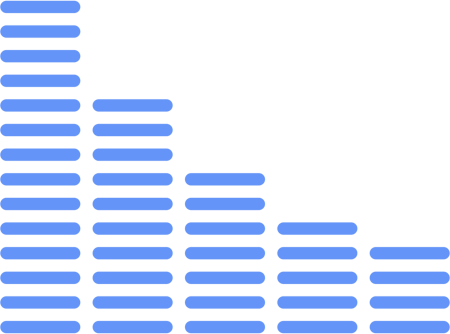
Productivity
For businesses, contaminated air reduces productivity, contributes to higher rates of employee absences, and can negatively affect employee health.
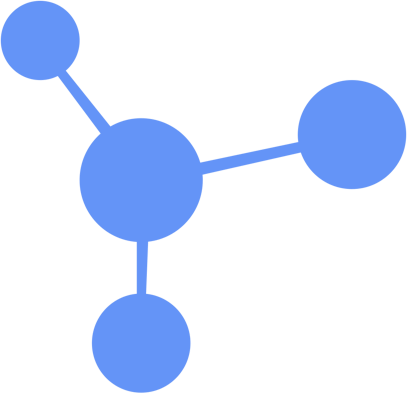
Health
Traditional air purification systems fail to remove the ultrafine particles that are the most harmful to employees and clients.

Efficiency
Upgrades to existing ventilation systems would require significant remodeling of building infrastructure and could be costly to implement.
Sectors
Nursing Homes
One serious issue in nursing homes is the high risk of airborne infection involved with patient cross-contamination. Gail Vittori, coordinator for the Green Guide for Health Care explains that “elderly people often suffer from weakened immune systems and age related health problems that make them more susceptible to the harmful effects of indoor air pollution.”
At CleanAirZone we know how important our technology is in nursing homes because of its effectiveness in reducing airborne infection and unpleasant odors, and maintaining a healthy breathing environment for patients, residents, and employees.
Case Study
“The implementation of CleanAirZone devices in the common area of our nursing home reduced dramatically the odors, improving the quality of life of our employees and patients.”
Edward Roy, nursing home owner in New Jersey

Data
“The graphic shows the dramatic reduction of contamination peaks during the busiest hours in the dining area of the nursing home.”
Country Nursing Home – Parsippany, NJ
VOC’s (Odorous gases)
Percentage of days (average) above 300pp Threshold
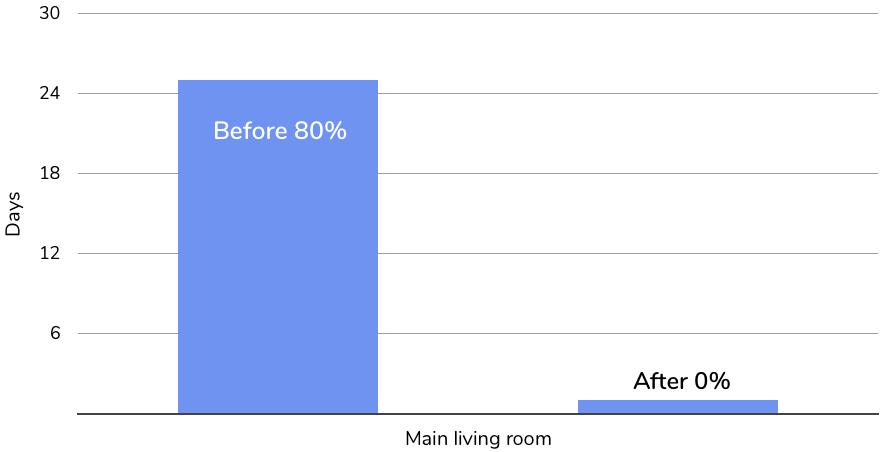
Supermarkets
Supermarket shoppers want to be certain that food for sale has been kept clean, fresh, and contaminant free.
CleanAirZone technology not only creates an environment where supermarket staff and customers can breathe high quality, clean air, but also helps keep products fresh and long-lasting.
The CleanAirZone system represents a dramatic reduction in costs compared to conventional methods, and the promise of clean air increases a company’s appeal to prospective customers and clients.
Case Study
“Enjoying clean, healthy air in our supermarket helped us take care of our people and our products.”
John Watson, supermarket owner in Brooklyn, NY

Data
“The graph shows the reduction of contamination in the first three weeks after the installation of the CleanAirZone devices.”
Fish market located in Brooklyn

Gym/Sports Facilities
Due to intense physical activity, gyms, yoga studios, and indoor sports facilities may become contaminated by harmful airborne particles and unpleasant odors. A recent study cited in the journal Building and Environment found unacceptably high levels of particle pollution in multiple indoor fitness centers and bathrooms.
The CleanAirZone system is capable of fully eliminating these odors and pollutant particles within three weeks of installation.
Case Study
“My students have improved their performance since the CleanAirZone device was installed. It was definitely a great investment!”
Caroline, owner of Dupont Yoga Studio, Washington D.C
Data
“The graph shows a reduction of over 70% in VOCs and odors during the practice of hot yoga.”
Dupont Yoga Studio, Washington DC
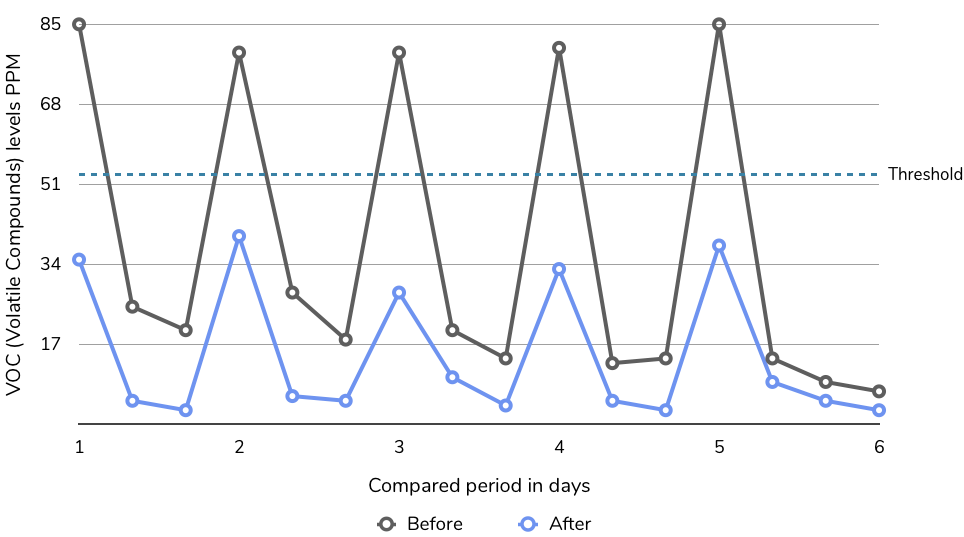
Athletes & Health
The CleanAirZone System dramatically reduces the air contamination in stables by over 70% and improves the health of the horses and their performances as athletes.
Approximately 17% of the general equine population has Inflammatory Airway Disease caused by the contaminated air mostly in the stalls that ultimately leads to a significant reduction in their athletic performance.
The individual devices installed in each stall act as artificial breathing assistants for the horses by capturing and eliminating these particles. This results in higher athletic performances and much lesser risk of airborne diseases for the horses.
Case Study
“The new air system fixes the problem. It is a solution. It is good for the horses, and it is good for the sport.”
Bode Miller, World Cup alpine ski racer
Data
“The CleanAirZone System dramatically reduces the air contamination in stables by over 70%”
Particulate reduction
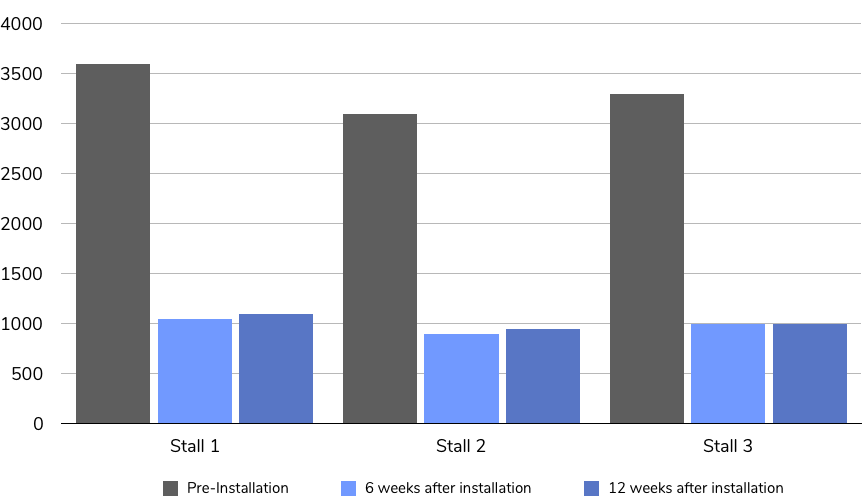
Printing Companies
The heavy use of solvents by printing companies dramatically impacts the health of their employees. Some companies even deal with contamination levels of up to 70 parts per million (ppm), meaning an employee would be forced to breathe in half a liter of solvents a year.
After installing the CleanAirZone system the printing company EarthColor was able to reduce contamination levels by 80%. They also cut energy costs by 40% because the CleanAirZone system reduced the use of the existing ventilation system.
Since installing the CleanAirZone system, rates of employee absences have dropped significantly, further illustrating the importance of a healthy, clean air environment.
Case Study
“EarthColor, one of the ten largest printing firms in the U.S., was a pioneer in their field by being an early adopter of the CleanAirZone system. They have dramatically reduced air contamination both inside and outside the factory.”
Robert Casen, EarthColor CEO

Data
“The graph shows a reduction of over 80% in VOC contamination in the most contaminated areas of the printing facility.”
Printing facility Earthcolor
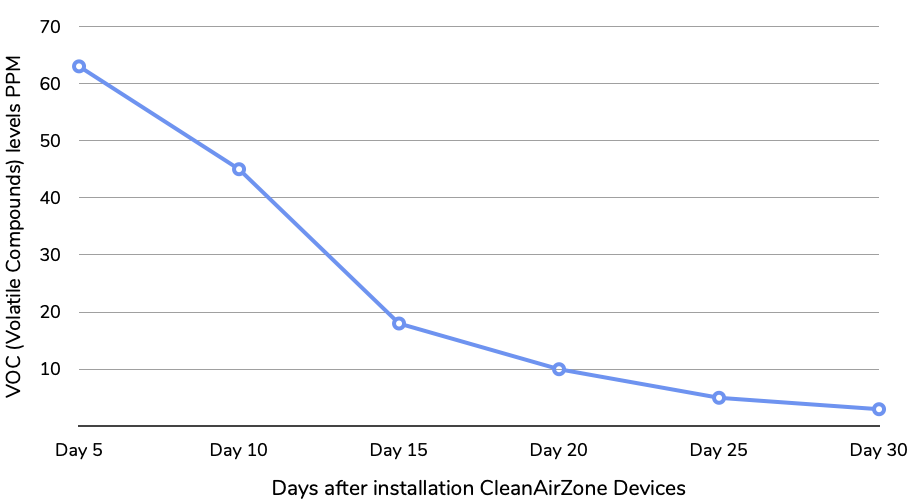
Nail Salons
In nail salons both employees and customers are exposed to a wide variety of volatile organic compounds (VOCs) from products like solvents, glues, and polishes. Some of these chemicals have short and long term adverse effects on one’s health.
A survey conducted by the New York City Health Department showed that 37% of salon employees suffered from skin problems, 37% reported eye irritation, 57% suffered from allergies, and 18% suffered from asthma.
With the CleanAirZone clean air system odors are significantly reduced within three weeks of installation. This improves both customer experience and enhances employee health and productivity.
Case Study
“After using the CleanAirZone system I no longer need to worry about the health of my employees and the well-being of our clients.”
Jazz Chang, nail salon owner in Great Neck, NY
Data
“The graphic shows the reduction of acetone, a common VOC found in nail salons, in just sixteen hours.”
Acetone
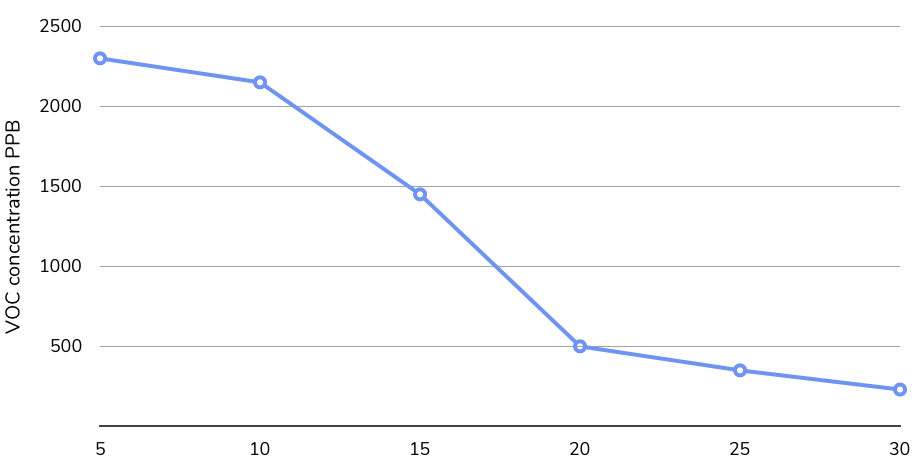
Hospitals
Like nursing homes, hospital staff and patients are often at risk of cross-contamination due to high levels of bacteria and airborne viral particles.
Presently, with the threat of new superbugs resistant to antibiotics, this issue has become all the more serious.
A study preformed at the University Hospitals of Cleveland shows that the CleanAirZone clean air system vastly reduces the risk to staff and patients in waiting rooms, operating rooms, inpatient wards, and intensive care units.
Case Study
“The installation of the CleanAirZone devices in the facilities of the University Hospitals of Cleveland showed a significant reduction in mold in the areas surrounding the devices.”
Dr. Edward Sobek

Data
“The graph shows a reduction of over 90% in mold contamination in the areas the CleanAirZone devices were located.”
Legionella degradation curves
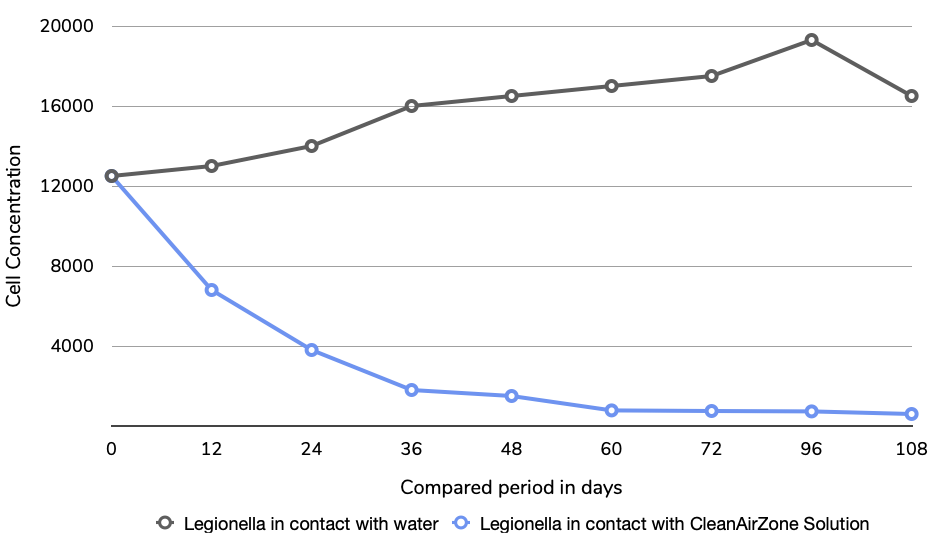
Emergency Services
In the event of a disaster, emergency services require tools and technologies which can assist them in providing help for people in need. Natural disasters such as floods, fires, hurricanes, and earthquakes often result in catastrophic levels of air pollution.
In 2010, in the town of Hasburg, Germany, the CleanAirZone system was successfully used to control high levels of mold contamination
The CleanAirZone system has been designed so that it can be installed without demanding changes to a building’s existing infrastructure.
Case Study
“The implementation of the CleanAirZone system in our construction site kept the levels of contamination low enough so my employees could perform their duties without being at risk.”
Edward Cox, construction manager based in New York

Data
“The graph shows the reduction of particulate matter overnight in the construction site.”
Levels of particle matter in the air
while heavy construction performed
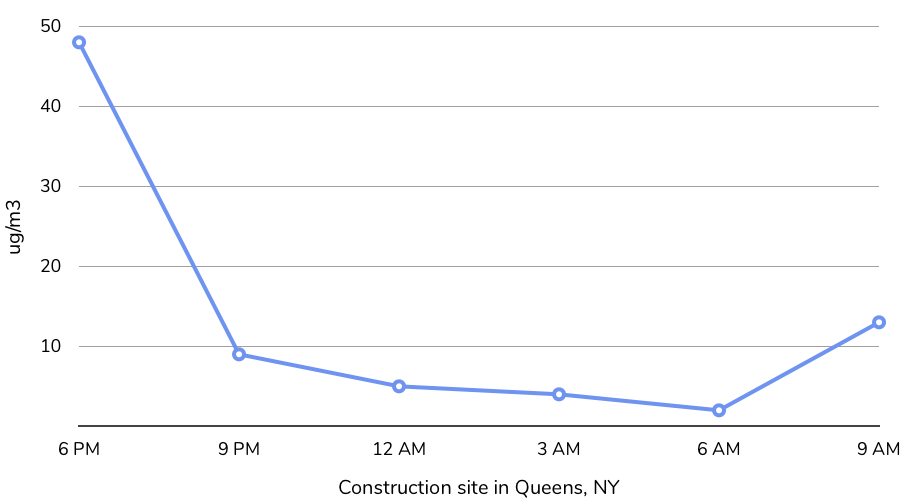
Controlled Environment Agriculture (CEA)
According to UN research published in 2019, the world will need 50% more food by 2050 and 70% of all fresh water will be dedicated to agriculture. Controlled Environment Agriculture (CEA) provides a solution to such global agricultural issues as water scarcity, arable land loss, population growth, energy efficiency, global warming, and food waste. CEA also provides a solution for reduced, or elimination, of chemicals and helps foster the rapid expansion of the rapidly growing “locally-grown” market that is fueled by consumer demand.
Despite better controlled ventilation and irrigation in CEA systems, disease and chemical damage can result between 5% to total losses of crops for CEA growers annually.
For the first time ever in the CEA market, the cleanest possible air environment with unmitigated control is upon us with the eradication of mold, mildew, pathogens and enriching the plant environment with abundant CO2.
“As agriculture struggles to support the rapidly growing global population, plant disease reduces the production and quality of food, fibre and biofuel crops. Losses may be catastrophic or chronic, but on average account for 42% of the production of the six most important food crops. Losses due to postharvest disease can be disastrous, especially when farms are a long way from markets and infrastructure and supply chain practices are poor. Many postharvest pathogens also produce toxins that create serious health problems for consumers.
Farmers spend billions of dollars are on disease management, often without adequate technical support, resulting in poor disease control, pollution and harmful results. In addition, plant disease can devastate natural ecosystems, compounding environmental problems caused by habitat loss and poor land management.
Crop losses tend to be greatest in tropical countries where environmental conditions are particularly favourable, incomes are low and knowledge and investments in crop health management are minimal. Disease losses can mean that communities become dependent on imported foods, often replacing a balanced diet with processed foods that create further health problems.
Plant breeders have very successfully increased potential crop yields, however the impacts of crop breeding for resource-poor farmers have been disappointing. Much greater emphasis is required to address reasons for the gap between potential and actual yields achieved by farmers, and research that is focused on narrowing this gap.
This issue is focused on research aimed at improving food security by reducing crop losses, particularly for low-income farmers. Manuscripts are invited that describe research into improving food security by reducing yield losses. Such research may include plant pathology, agronomy, entomology, weed science, farm management, improving resilience to abiotic constraints, postharvest handling, food safety, improved market access, the role of biotechnology, technology transfer, extension, education, policy and any other related topics.”
Prof. Dr. David Guest, School of Life and Environmental Sciences, University of Sydney, Sydney Australia
“Plant diseases in a typical greenhouse may cost as much as 15 per cent of potential income. Serious pest damage can take another 10 per cent from your bottom line.”
Rod Turner, General Manger, Risk Management at Plant Health Australia
Case Study
Clean Air Zone Agriculture (CAZAG) has partnered with one of the world’s largest commercial CEA growing facilities to begin testing CAZ products’ efficacy against some of the CEA growers’ most common diseases, such as powdery mildew and tomato brown rugose virus.
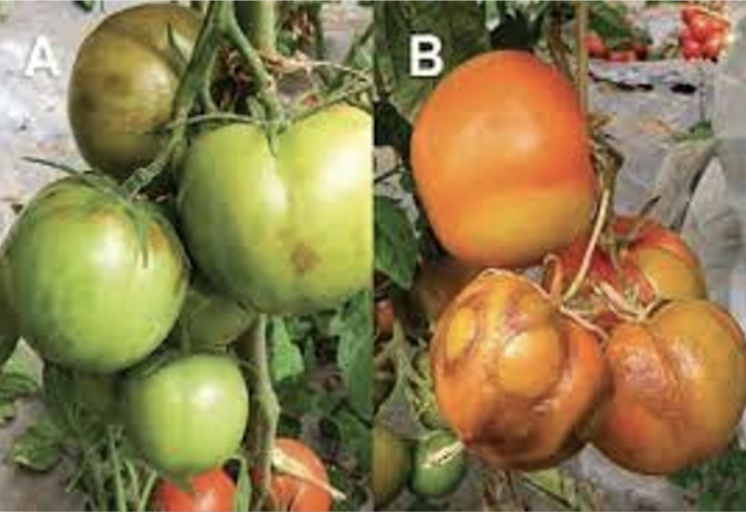
Tomato Brown Rugose Fruit Virus
Tomato brown rugose fruit virus (ToBRFV) is a recently identified virus affecting tomato, pepper and possibly their relatives.
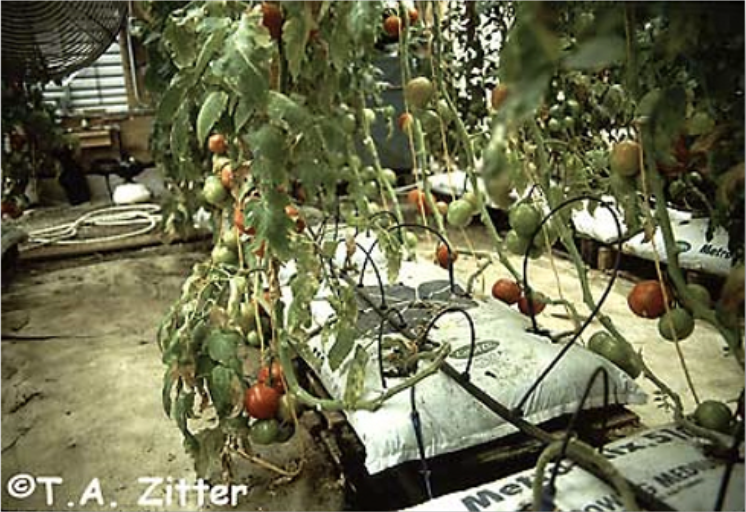
Powdery Mildew
Powdery mildew is disease that thrives in moist, humid enviroments affecting a wide range of plants.
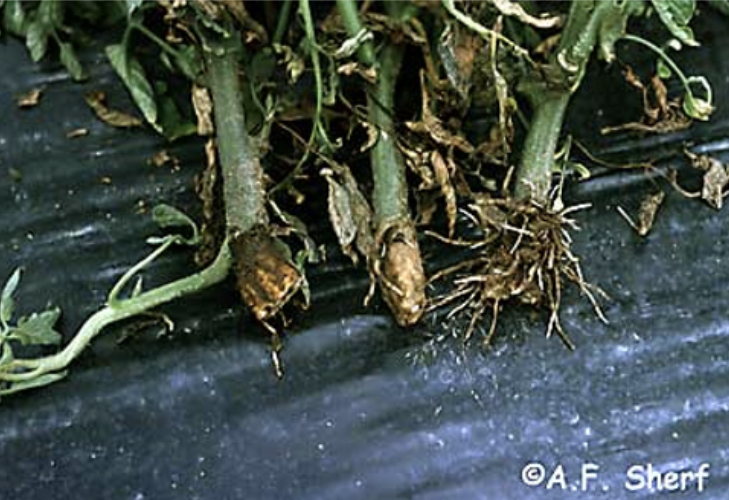
Chemical Damage
Various pesticides can damage crops and cause detrimental health effects to consumers.
Data
“The graphic shows the dramatic reduction of contamination peaks in a greenhouse.”
Greenhouse
VOC’s (Odorous gases)
Percentage of days (average) above 300pp Threshold

Residential
The CleanAirZone System improves health by eliminating contaminants in the air at home and the workplace and by dramatically reducing airborne mold. The EPA warns that the immediate effects of mold include irritation to the eyes, nose, and throat as well as cause headaches, dizziness, and fatigue.
The CleanAirZone System is the only 100% green technology capable of capturing and eliminating all types of mold, VOCs, allergens, bacteria, and viruses.
At CleanAirZone we believe our homes and apartments should be places where people can feel safe while surrounded by clean healthy air.
Case Study
“Before trying the CleanAirZone System, my family and I suffered from headaches every morning due to mold in our house. But now we’re able to breathe fresh air again.”
David Susman, homeowner
Data
“In a few minutes, the CleanAirZone System dramatically reduces the mold contamination”.
Mold reduction
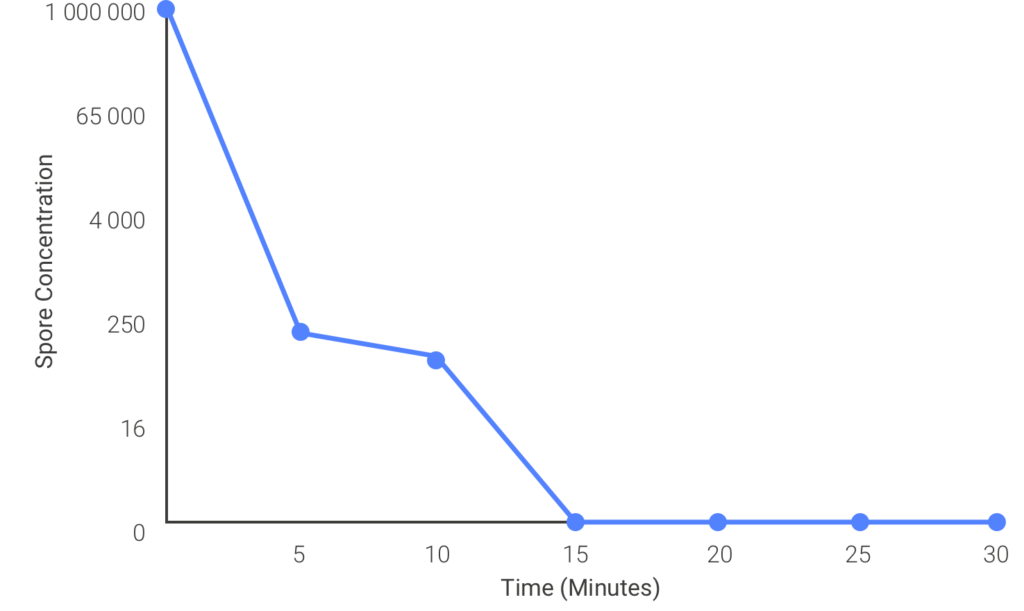
Sectors
Nursing Homes
One serious issue in nursing homes is the high risk of airborne infection involved with patient cross-contamination. Gail Vittori, coordinator for the Green Guide for Health Care explains that “elderly people often suffer from weakened immune systems and age related health problems that make them more susceptible to the harmful effects of indoor air pollution.”
At CleanAirZone we know how important our technology is in nursing homes because of its effectiveness in reducing airborne infection and unpleasant odors, and maintaining a healthy breathing environment for patients, residents, and employees.
Case Study
“The implementation of CleanAirZone devices in the common area of our nursing home reduced dramatically the odors, improving the quality of life of our employees and patients.”
Edward Roy, nursing home owner in New Jersey

Data
“The graphic shows the dramatic reduction of contamination peaks during the busiest hours in the dining area of the nursing home.”
Country Nursing Home – Parsippany, NJ
VOC’s (Odorous gases)
Percentage of days (average) above 300pp Threshold

Supermarkets
Supermarket shoppers want to be certain that food for sale has been kept clean, fresh, and contaminant free.
CleanAirZone technology not only creates an environment where supermarket staff and customers can breathe high quality, clean air, but also helps keep products fresh and long-lasting.
The CleanAirZone system represents a dramatic reduction in costs compared to conventional methods, and the promise of clean air increases a company’s appeal to prospective customers and clients.
Case Study
“Enjoying clean, healthy air in our supermarket helped us take care of our people and our products.”
John Watson, supermarket owner in Brooklyn, NY

Data
“The graph shows the reduction of contamination in the first three weeks after the installation of the CleanAirZone devices.”
Fish market located in Brooklyn

Gym/Sports Facilities
Due to intense physical activity, gyms, yoga studios, and indoor sports facilities may become contaminated by harmful airborne particles and unpleasant odors. A recent study cited in the journal Building and Environment found unacceptably high levels of particle pollution in multiple indoor fitness centers and bathrooms.
The CleanAirZone system is capable of fully eliminating these odors and pollutant particles within three weeks of installation.
Case Study
“My students have improved their performance since the CleanAirZone device was installed. It was definitely a great investment!”
Caroline, owner of Dupont Yoga Studio, Washington D.C
Data
“The graph shows a reduction of over 70% in VOCs and odors during the practice of hot yoga.”
Dupont Yoga Studio, Washington DC

Athletes & Health
The CleanAirZone System dramatically reduces the air contamination in stables by over 70% and improves the health of the horses and their performances as athletes.
Approximately 17% of the general equine population has Inflammatory Airway Disease caused by the contaminated air mostly in the stalls that ultimately leads to a significant reduction in their athletic performance.
The individual devices installed in each stall act as artificial breathing assistants for the horses by capturing and eliminating these particles. This results in higher athletic performances and much lesser risk of airborne diseases for the horses.
Case Study
“The new air system fixes the problem. It is a solution. It is good for the horses, and it is good for the sport.”
Bode Miller, World Cup alpine ski racer
Data
“The CleanAirZone System dramatically reduces the air contamination in stables by over 70%”
Particulate reduction

Printing Companies
The heavy use of solvents by printing companies dramatically impacts the health of their employees. Some companies even deal with contamination levels of up to 70 parts per million (ppm), meaning an employee would be forced to breathe in half a liter of solvents a year.
After installing the CleanAirZone system the printing company EarthColor was able to reduce contamination levels by 80%. They also cut energy costs by 40% because the CleanAirZone system reduced the use of the existing ventilation system.
Since installing the CleanAirZone system, rates of employee absences have dropped significantly, further illustrating the importance of a healthy, clean air environment.
Case Study
“EarthColor, one of the ten largest printing firms in the U.S., was a pioneer in their field by being an early adopter of the CleanAirZone system. They have dramatically reduced air contamination both inside and outside the factory.”
Robert Casen, EarthColor CEO

Data
“The graph shows a reduction of over 80% in VOC contamination in the most contaminated areas of the printing facility.”
Printing facility Earthcolor

Nail Salons
In nail salons both employees and customers are exposed to a wide variety of volatile organic compounds (VOCs) from products like solvents, glues, and polishes. Some of these chemicals have short and long term adverse effects on one’s health.
A survey conducted by the New York City Health Department showed that 37% of salon employees suffered from skin problems, 37% reported eye irritation, 57% suffered from allergies, and 18% suffered from asthma.
With the CleanAirZone clean air system odors are significantly reduced within three weeks of installation. This improves both customer experience and enhances employee health and productivity.
Case Study
“After using the CleanAirZone system I no longer need to worry about the health of my employees and the well-being of our clients.”
Jazz Chang, nail salon owner in Great Neck, NY
Data
“The graphic shows the reduction of acetone, a common VOC found in nail salons, in just sixteen hours.”
Acetone

Museums
On average, human beings spend 80% of their time in indoor spaces, so it is of utmost importance to maintain clean air environments indoors in order to preserve health and prevent illness. Museums are visited by a large number of people on a daily basis. For instance, the Museum of Modern Art (MoMA) in New York City receives an average of 10,000 visitors per day. This high rate of visitors in a single space creates a greater risk of exposure to various airborne pathogens.
The Museum of Modern Art decided to use the CleanAirZone system to relieve air pollution from an exhibition space by the artist Tania Bruguera in order to prevent harm to the health of employees and visitors and damage to her work.
Case Study
“Thanks to CleanAirZone technology the MoMA was able to guarantee the safety of MoMA employees and visitors during the exhibition of Tania Bruguera.”
Data
“The tunnel that MoMA built to host the Bruguera exhibition was facing a big problem of mold due to humidity and sugar particles contained in the air. A comparison with a monitor placed right outside of the tunnel showed that levels of mold inside, where the CleanAirZone devices were located, were even lower than outside. The CleanAirZone system kept the levels of mold inside the exhibition under 2,000 spores per cubic meter, the same levels of a healthy apartment.”
Spores per cubic meter of air
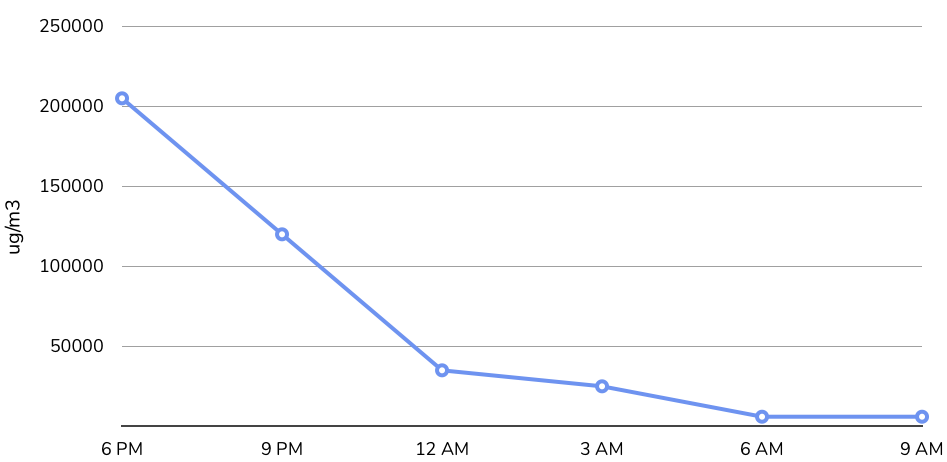
Hospitals
Like nursing homes, hospital staff and patients are often at risk of cross-contamination due to high levels of bacteria and airborne viral particles.
Presently, with the threat of new superbugs resistant to antibiotics, this issue has become all the more serious.
A study preformed at the University Hospitals of Cleveland shows that the CleanAirZone clean air system vastly reduces the risk to staff and patients in waiting rooms, operating rooms, inpatient wards, and intensive care units.
Case Study
“The installation of the CleanAirZone devices in the facilities of the University Hospitals of Cleveland showed a significant reduction in mold in the areas surrounding the devices.”
Dr. Edward Sobek

Data
“The graph shows a reduction of over 90% in mold contamination in the areas the CleanAirZone devices were located.”
Legionella degradation curves

Emergency Services
In the event of a disaster, emergency services require tools and technologies which can assist them in providing help for people in need. Natural disasters such as floods, fires, hurricanes, and earthquakes often result in catastrophic levels of air pollution.
In 2010, in the town of Hasburg, Germany, the CleanAirZone system was successfully used to control high levels of mold contamination
The CleanAirZone system has been designed so that it can be installed without demanding changes to a building’s existing infrastructure.
Case Study
“The implementation of the CleanAirZone system in our construction site kept the levels of contamination low enough so my employees could perform their duties without being at risk.”
Edward Cox, construction manager based in New York

Data
“The graph shows the reduction of particulate matter overnight in the construction site.”
Levels of particle matter in the air
while heavy construction performed

Controlled Environment Agriculture (CEA)
According to UN research published in 2019, the world will need 50% more food by 2050 and 70% of all fresh water will be dedicated to agriculture. Controlled Environment Agriculture (CEA) provides a solution to such global agricultural issues as water scarcity, arable land loss, population growth, energy efficiency, global warming, and food waste. CEA also provides a solution for reduced, or elimination, of chemicals and helps foster the rapid expansion of the rapidly growing “locally-grown” market that is fueled by consumer demand.
Despite better controlled ventilation and irrigation in CEA systems, disease and chemical damage can result between 5% to total losses of crops for CEA growers annually.
For the first time ever in the CEA market, the cleanest possible air environment with unmitigated control is upon us with the eradication of mold, mildew, pathogens and enriching the plant environment with abundant CO2.
“As agriculture struggles to support the rapidly growing global population, plant disease reduces the production and quality of food, fibre and biofuel crops. Losses may be catastrophic or chronic, but on average account for 42% of the production of the six most important food crops. Losses due to postharvest disease can be disastrous, especially when farms are a long way from markets and infrastructure and supply chain practices are poor. Many postharvest pathogens also produce toxins that create serious health problems for consumers.
Farmers spend billions of dollars are on disease management, often without adequate technical support, resulting in poor disease control, pollution and harmful results. In addition, plant disease can devastate natural ecosystems, compounding environmental problems caused by habitat loss and poor land management.
Crop losses tend to be greatest in tropical countries where environmental conditions are particularly favourable, incomes are low and knowledge and investments in crop health management are minimal. Disease losses can mean that communities become dependent on imported foods, often replacing a balanced diet with processed foods that create further health problems.
Plant breeders have very successfully increased potential crop yields, however the impacts of crop breeding for resource-poor farmers have been disappointing. Much greater emphasis is required to address reasons for the gap between potential and actual yields achieved by farmers, and research that is focused on narrowing this gap.
This issue is focused on research aimed at improving food security by reducing crop losses, particularly for low-income farmers. Manuscripts are invited that describe research into improving food security by reducing yield losses. Such research may include plant pathology, agronomy, entomology, weed science, farm management, improving resilience to abiotic constraints, postharvest handling, food safety, improved market access, the role of biotechnology, technology transfer, extension, education, policy and any other related topics.”
Prof. Dr. David Guest, School of Life and Environmental Sciences, University of Sydney, Sydney Australia
“Plant diseases in a typical greenhouse may cost as much as 15 per cent of potential income. Serious pest damage can take another 10 per cent from your bottom line.”
Rod Turner, General Manger, Risk Management at Plant Health Australia
Case Study
Clean Air Zone Agriculture (CAZAG) has partnered with one of the world’s largest commercial CEA growing facilities to begin testing CAZ products’ efficacy against some of the CEA growers’ most common diseases, such as powdery mildew and tomato brown rugose virus.

Tomato Brown Rugose Fruit Virus
Tomato brown rugose fruit virus (ToBRFV) is a recently identified virus affecting tomato, pepper and possibly their relatives.

Powdery Mildew
Powdery mildew is disease that thrives in moist, humid enviroments affecting a wide range of plants.

Chemical Damage
Various pesticides can damage crops and cause detrimental health effects to consumers.
Data
“The graphic shows the dramatic reduction of contamination peaks in a greenhouse.”
Greenhouse
VOC’s (Odorous gases)
Percentage of days (average) above 300pp Threshold

Residential
The CleanAirZone System improves health by eliminating contaminants in the air at home and the workplace and by dramatically reducing airborne mold. The EPA warns that the immediate effects of mold include irritation to the eyes, nose, and throat as well as cause headaches, dizziness, and fatigue.
The CleanAirZone System is the only 100% green technology capable of capturing and eliminating all types of mold, VOCs, allergens, bacteria, and viruses.
At CleanAirZone we believe our homes and apartments should be places where people can feel safe while surrounded by clean healthy air.
Case Study
“Before trying the CleanAirZone System, my family and I suffered from headaches every morning due to mold in our house. But now we’re able to breathe fresh air again.”
David Susman, homeowner
Data
“In a few minutes, the CleanAirZone System dramatically reduces the mold contamination”.
Mold reduction

Pollutants
People with mold allergies may have more severe reactions. Immune-compromised people and people with chronic lung illnesses, such as obstructive lung disease, may get serious infections in their lungs when they are exposed to mold.
